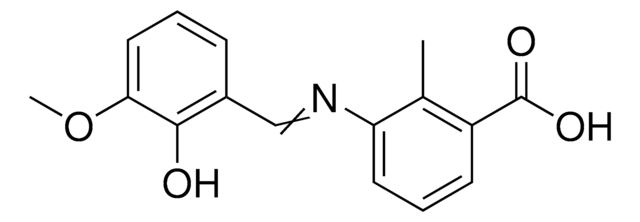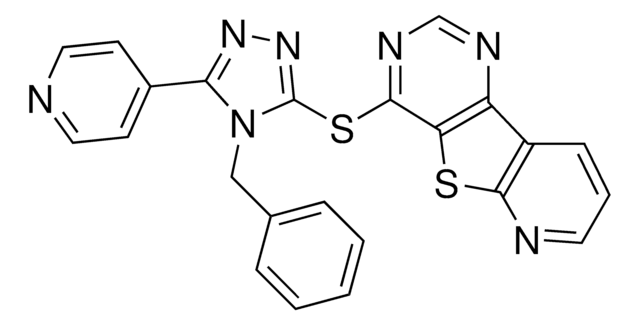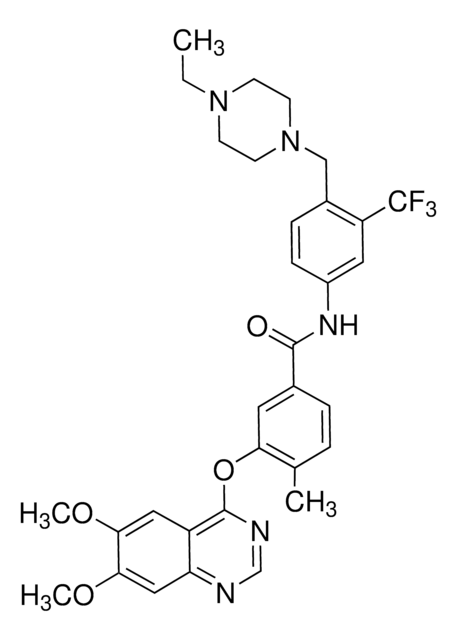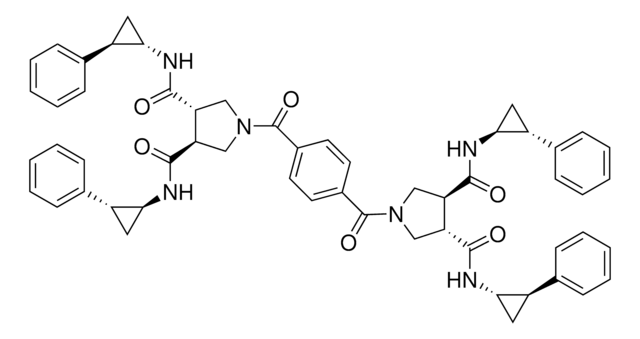5.32583
TLR1/TLR2 Agonist II, CU-T12-9
Sinônimo(s):
TLR1/TLR2 Agonist II, CU-T12-9, N-Methyl-4-nitro-2-(4-(4-(trifluoromethyl)phenyl)-1H-imidazol-1-yl)aniline, CUT129
Faça loginpara ver os preços organizacionais e de contrato
About This Item
Fórmula empírica (Notação de Hill):
C17H13F3N4O2
Número CAS:
Peso molecular:
362.31
Código UNSPSC:
12352200
NACRES:
NA.77
Produtos recomendados
Ensaio
≥98% (HPLC)
Nível de qualidade
Formulário
powder
fabricante/nome comercial
Calbiochem®
condição de armazenamento
OK to freeze
protect from light
cor
yellow
solubilidade
DMSO: 50 mg/mL
temperatura de armazenamento
2-8°C
Descrição geral
A diphenyl substituted imidazole based compound that directly and selectively targets TLR1/2 and induces their dimerization and activates TLR1 & 2 signaling leading to NF-κB and AP-1 activation (KD = 182 and 478 nM, respectively; EC50 = 52.9 nM for TLR2 in HEK-Blue cells over-expressing hTLR2). Does not affect the dimerization of TLR2/TLR6 and exhibits poor affinity towards TLR3, TLR4, TLR5, TLR7 and TLR8. Shown to compete with Pam3CSK4 (Cat. No. 506350; Ki = 45.4 nM) for binding to TLR1/2 interface and enhance heterodimerization. Up-regulates the expression of TLR1, TLR2, TNFα, IL-10, and iNOS in RAW 264.7 macrophages in a time-dependent manner. Shown to be non-toxic up to 100 µM concentration.
Please note that the molecular weight for this compound is batch-specific due to variable water content.
Please note that the molecular weight for this compound is batch-specific due to variable water content.
A non-cytotoxic (up to 100 µM) diphenyl-substituted imidazole compound that exhibits high affinity toward both TLR1 & TLR2 (KD = 182 nM & 478 nM, respectively) and induces TLR1/2 heterodimerization, effectively completing against Pam3CSK4 (Cat. No. 506350) for TLR1/2 binding (Ki = 45.4 nM; [Pam3] = 20 mg/mL; [TLR1/2] = 80 nM). Shown to potently induce secreted embryonic alkaline phosphatase (SEAP) production from human TLR2-, but not TLR3-, 4-, 5-, 7-, 8-, transfected HEK293 (EC50 = 52.9 nM) in an NF-κB inhibitor Triptolide-(Cat. No. 645900) blockable manner via selective TLR1/2, but not TLR2/6, heterodimer activation. Reported to induce comparable NF-κB-dependent reporter transcription as 100 ng/mL Pam3CSK4 when administered to human macrophage U937 cultures at 5 µM concentration (24 h) and effectively trigger NO production in both murine Raw 264.7 and primary rat macrophage cultures (ECmax = 1.2 & 0.4 µM, respectively; 24 h), blockable by TLR1/2 antagonist CU-CPT22 (Cat. No. 614305), but not TLR4 antagonist TAK-242 (Cat. No. 614316 & 508336). Likewise, both CU-T12-9 and Pam3CSK4 (1 µM & 50 ng/mL, respectively) are demonstrated to induce similar time-dependent induction of TLR1, TLR2, TNF-α, iNOS, IL-10 mRNA in Raw 264.7 cells.
TLR1/TLR2 Agonist & CU-T12-9
Ações bioquímicas/fisiológicas
Primary Target
TLR1/TLR2
TLR1/TLR2
Reversible: yes
Advertência
Toxicity: Standard Handling (A)
Reconstituição
Following reconstitution, aliquot and freeze (-20°C). Stock solutions are stable for up to 3 months at -20°C.
Outras notas
Cheng, K., et al. 2014. Manuscript in preparation.
Informações legais
CALBIOCHEM is a registered trademark of Merck KGaA, Darmstadt, Germany
Código de classe de armazenamento
11 - Combustible Solids
Classe de risco de água (WGK)
WGK 3
Ponto de fulgor (°F)
Not applicable
Ponto de fulgor (°C)
Not applicable
Certificados de análise (COA)
Busque Certificados de análise (COA) digitando o Número do Lote do produto. Os números de lote e remessa podem ser encontrados no rótulo de um produto após a palavra “Lot” ou “Batch”.
Já possui este produto?
Encontre a documentação dos produtos que você adquiriu recentemente na biblioteca de documentos.
Nossa equipe de cientistas tem experiência em todas as áreas de pesquisa, incluindo Life Sciences, ciência de materiais, síntese química, cromatografia, química analítica e muitas outras.
Entre em contato com a assistência técnica








